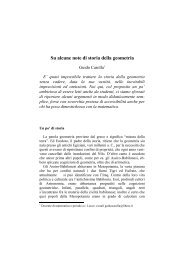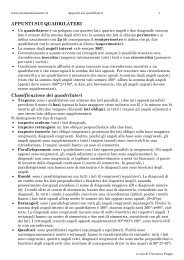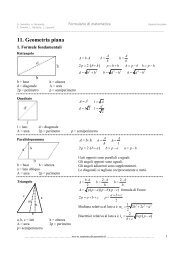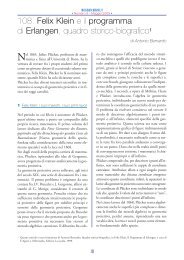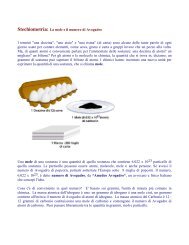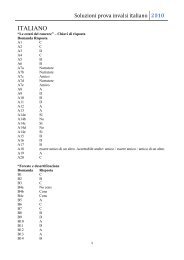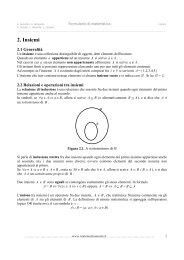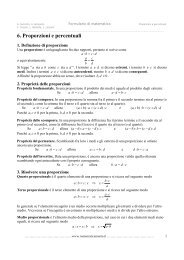α = √ (2 + √ (2 + √ (2 +… - Matematicamente.it
α = √ (2 + √ (2 + √ (2 +… - Matematicamente.it
α = √ (2 + √ (2 + √ (2 +… - Matematicamente.it
Create successful ePaper yourself
Turn your PDF publications into a flip-book with our unique Google optimized e-Paper software.
4.) Analisi<br />
Al variare del numero dei lati del poligono regolare inscr<strong>it</strong>to nel cerchio di raggio un<strong>it</strong>ario, si determinano i<br />
valori del parametro <strong>α</strong> funzione della lunghezza del lato del poligono.<br />
β = 3 corrisponde all’ottagono<br />
β = 4 corrisponde al poligono di sedici lati<br />
β = 5 corrisponde al poligono di trentadue lati<br />
β = ∞ corrisponde al poligono di infin<strong>it</strong>i lati ovvero alla circonferenza<br />
si ottengono dalla 1.8 le seguenti risultanze al variare di β<br />
β = 3 <strong>α</strong> = <strong>√</strong> 2 π = 3,061<br />
β = 4 <strong>α</strong> = <strong>√</strong> (2+<strong>√</strong> 2) π = 3,1214<br />
β = 5 <strong>α</strong> = <strong>√</strong> (2+<strong>√</strong> (2+<strong>√</strong> 2)) π = 3,1365<br />
β = 6 <strong>α</strong> = <strong>√</strong> (2+<strong>√</strong> (2+<strong>√</strong> (2+<strong>√</strong> 2))) π = 3,14033<br />
β = 7 <strong>α</strong> = <strong>√</strong> (2+<strong>√</strong> (2+<strong>√</strong> (2+<strong>√</strong> (2+<strong>√</strong> 2)))) π = 3,141277<br />
β = 8 <strong>α</strong> = <strong>√</strong> (2+<strong>√</strong> (2+<strong>√</strong> (2+<strong>√</strong> (2+<strong>√</strong>( 2+<strong>√</strong> 2))))) π = 3,1415138<br />
β = 9 <strong>α</strong> = <strong>√</strong> (2+<strong>√</strong> (2+<strong>√</strong> (2+<strong>√</strong> (2+<strong>√</strong>( 2+<strong>√</strong> (2+<strong>√</strong> 2)))))) π = 3,1415729<br />
β = 10 <strong>α</strong> = <strong>√</strong> (2+<strong>√</strong> (2+<strong>√</strong> (2+<strong>√</strong> (2+<strong>√</strong>( 2+<strong>√</strong> (2+<strong>√</strong> (2+<strong>√</strong> 2))))))) π = 3,1415877<br />
β = 11 <strong>α</strong> = <strong>√</strong> (2+<strong>√</strong> (2+<strong>√</strong> (2+<strong>√</strong> (2+<strong>√</strong>( 2+<strong>√</strong> (2+<strong>√</strong> (2+<strong>√</strong> (2+<strong>√</strong> 2)))))))) π = 3,14159142<br />
β = 12 <strong>α</strong> = <strong>√</strong> (2+<strong>√</strong> (2+<strong>√</strong> (2+<strong>√</strong> (2+<strong>√</strong>( 2+<strong>√</strong> (2+<strong>√</strong> (2+<strong>√</strong> (2+<strong>√</strong> (2+<strong>√</strong> 2))))))))) π = 3,141592345<br />
β = ∞ <strong>α</strong> = 2 π = 3,141592654…<br />
Gianbattista Bergonzi “Il pigreco nella radice di due” pagina 4 di 7





